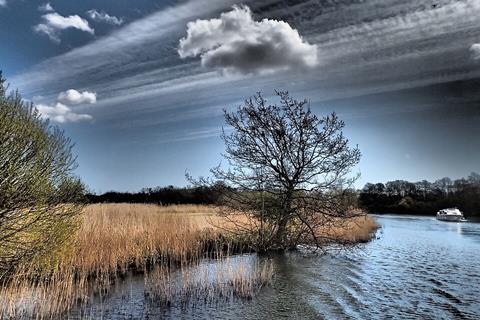A scientific initiative to combat harmful Prymnesium algal blooms in the Broads is gaining fresh momentum, thanks to a renewed collaboration between the University of East Anglia (UEA), the Environment Agency, the Broads Authority, and the Norfolk pike angling community.

Prymnesium algal blooms can occur on the Broads and produce toxins that threaten fish stocks, local biodiversity, and East Anglia’s thriving angling industry, which contributes more than £100 million annually to the local economy.
READ MORE: Marine algae use massive enzymes of unprecedented size to biosynthesize fish-killing toxins
READ MORE: Study tracks algae species interactions to help predict harmful algae blooms
The golden algae Prymnesium parvum is therefore of significant research interest to prevent environmental incidents and associated fish mortalities from occurring.
Triggers of blooms
Researchers at UEA are working to better understand the environmental, chemical and biological conditions that trigger these Prymnesium blooms and find solutions to prevent their harmful impact.
While this long-term research project has been active for nearly a decade, with the return of researcher Prof Rob Field to UEA, this work is regaining momentum and support.
The initiative has received strong support from Norfolk’s angling community, which has donated nearly £4,000 to the research effort and is actively assisting in water sampling across the Broads National Park.
This grassroots involvement underscores the urgency of tackling this environmental challenge and the strong public interest in finding sustainable solutions.
Key to future
Prof Field, Pro-Vice Chancellor for UEA’s Faculty of Science, said: “This research is crucial for the future of the Broads’ ecosystem and economy.
“With the support of local anglers and environmental agencies, we are making significant strides in understanding and heading off harmful algal blooms.”
The research will involve laboratory work and field studies to identify specific locations at risk of Prymnesium blooms, how it is impacted by nutrient levels and salinity and how these factors can influence blooms.
Devastating effects
John Currie, Chairman of the Norwich and District Pike Club, said: “Local anglers well know the devastating effects caused by a toxic Prymnesium bloom and the negative effects on the whole ecosystem.
“My experience over many years in communicating with scientists from around the globe who specialise on the subject qualifies me to say how gratified I am that we now have on our doorstep scientists who are world leaders on all aspects of Prymnesium.
“I look forward to what Rob and his team come up with next as their past work has been inspirational.”
Rich biodiversity
As the research progresses, stakeholders hope to develop strategies to safeguard Norfolk’s waterways and preserve its rich biodiversity.
Broads Authority Environment Policy Adviser Andrea Kelly said: “We are delighted that this research to better understand what triggers algal blooms of Prymnesium parvum is taking place in the Broads.
“Preventing Prymnesium algal blooms will help protect populations of fish, Broads angling and improve our management of the navigation.”
Recent breakthroughs from the UEA and John Innes Centre have revealed crucial insights into how and when these algae produce toxins, and how the toxins are released into the environment.







No comments yet